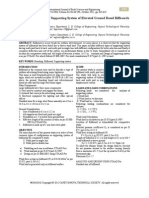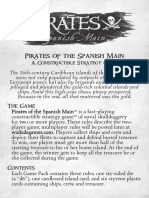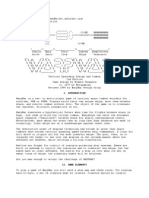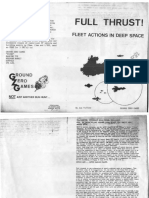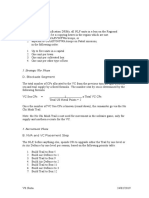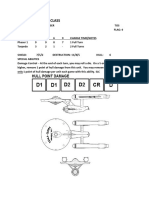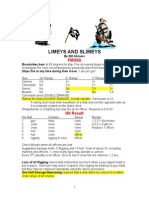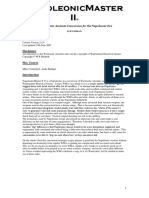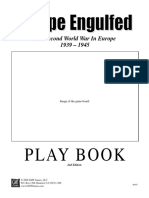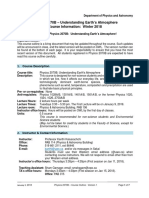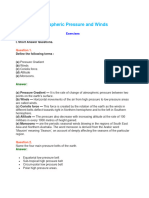Letters of Marque
Letters of Marque
Uploaded by
ddobriloCopyright:
Available Formats
Letters of Marque
Letters of Marque
Uploaded by
ddobriloCopyright
Available Formats
Share this document
Did you find this document useful?
Is this content inappropriate?
Copyright:
Available Formats
Letters of Marque
Letters of Marque
Uploaded by
ddobriloCopyright:
Available Formats
Letters of Marque
A light naval wargame for two players or teams for use with Pirates of the Spanish Main by Dennis Ugolini Version 0.9
Table of Contents 1 Introduction
Letters of Marque is an attempt to create a light but involving naval wargame for use with the excellent constructable ships in the WizKids collectible game Pirates of the Spanish Main. It combines a simplified version of the movement and wind rules from Avalon Hills Wooden Ships & Iron Men, with much of the combat system from Games Workshops Man O War, and a little dash of inspiration (such as the ship names) from the 1987 computer game Sid Meiers Pirates!. Id love to get feedback on the game; please send any comments or suggestions to dugolini@trinity.edu.
2 Preparing to Play
2.1Components To start playing Letters of Marque, you will need the following: A blue hex mat to represent the waters of the Caribbean; 1 hexes work best Island or coastal terrain (optional) An arrow marker to record wind direction Lots of Pirates of the Spanish Main ships A record sheet for each ship (included at the end of these rules) At least four six-sided dice (but bring some for everybody) 2.2Fleet Selection Each player or team should choose a fleet equaling a set point value (20 for a quick engagement, 30 or more for a longer team game). The ships are classified and valued as shown below. Note that in Letters of Marque, there are no unique ship abilities, nor are there differences between English, Spanish, or Pirate ships of the same class.
Pinnace 2 points
Sloop 3 points
Barque 4 points
Merchantman 5 points points
Frigate 6 points
War
Galleon
If your ship collections are too unbalanced to generate two equal fleets (not an uncommon problem with a collectible game), or if you want to try a different sort of engagement, have the smaller fleet defend a coastal city with one or more Shore Forts. Each fort is worth 4 points. A record sheet and special rules for the Shore Fort are given at the end of these rules. 2.3Setting Up Layout the hex mat and terrain in a mutually-agreeable manner. If one side is defending a city, she should place any coastline and Shore Forts on her side of the map first. The city need not be modeled; the forts can guard an inlet leading off the map. For other terrain features, the Man O War rules suggest dividing the board into four or six sections (depending on whether your map is square or rectangular) and rolling a d6 for each: Roll 1.2 3-4 5 6 Number of Terrain Features Present None One terrain feature Two terrain features Three terrain features
Make sure that it is clear which hexes are blocked by a terrain feature, and that there is at least two hexes between terrain features everywhere on the map. The wind must always point along a line of hexes, and thus can point in six possible directions. Use a d6 to randomly determine the initial wind direction, and record it on the map with your arrow marker. Finally, the players should place their fleets. Each ship should take up two hexes on the board, and all ships must start entirely within four hexes of the owning players map edge. If
there is a city defender, this player or team should set up first, followed by the attackers. Otherwise use one of these methods: The players or teams alternate placing one ship at a time Place a dividing screen across the middle of the map, and have both sides deploy simultaneously in secret
3 Sequence of Play
Each turn of Letters of Marque consists of three phases: the Initiative Phase, Battle Phase, and End Phase. 3.1Initiative Phase One player on each side rolls a d6. The side that rolls higher will move first in the Battle Phase. If the roll is a tie, the wind direction will change. Rotate the wind arrow 600 clockwise if both players rolled even numbers, or 600 counterclockwise if both players rolled odd numbers. The players should then roll again for initiative. The wind my change direction several times in a single Initiative Phase. 3.2Battle Phase The side that won initiative selects one ship to move, and either shoot or perform boarding actions. The opposing side then chooses one ship and does the same. The two sides take turns until all ships have performed their actions. A player cannot pass when it is her turn to act. No ship mave more or shoot more than once in a Battle Phase. 3.3End Phase Various bookkeeping tasks are performed in the End Phase sunken wreckage is removed, fires spread or go out, captured ships are recrewed or scuttled, and No Move/No Fire counters are removed. Players then begin the Initiative Phase of the next turn.
4 Movement
4.1Choosing Sail Before moving, the player must decide whether the ship will be using regular or full sail. All ships in Letters of Marque have a Speed of either 4(6) or 3(5). A ship under regular sail will use the first number, while a ship under full sail will use the second number (the one in parentheses). While full sail gives a ship greater speed, it also makes it more vulnerable to cannon fire while under full sail, the ship gets no saving throws for any hit on its Masts. If the player chooses to use full sail, she places a Full Sail marker next to the ship on the playing map. The ship will remain under full sail until its next movement phase. If any of a ships Masts are destroyed, it immediately reverts to regular sail and may not use full sail for the remainder of the game. 4.2Determining Number of Moves The number of moves a ship may take is determined from the ships Speed and the wind direction. A ship will always be in one of four possible orientations, as A shown at right: directly into the wind (A), diagonally into the wind (B), diagonally with the wind (C), and directly with the wind (D). For each B case, the ships movement allowance is as follows: A: Zero, regardless of speed. The ship may still pivot once (see next section). B: One if at regular sail, two if at full sail. C: Equal to the ships Speed. D: Equal to the ships Speed minus one (but never less than 1).
C D
The movement allowance for each Speed and wind direction is illustrated on the Quick Reference Card at the end of the rules. If a ship has lost all of its Masts, it may not move regardless of wind direction. 4.3Moving the Ship A legal move consists of moving the ship one hex either straight forward, or with a 60 0 turn to either the left or right. These moves correspond to a, b, and c on the next page. A ship facing directly into the wind has a movement allowance of zero, but may make one pivot 600 to either the left or right with the bow fixed in place; these moves correspond to d and e on the next page. Note that a ship that has lost all of its Masts may not pivot; it cannot move at all.
A ship is limited in the number of 600 turns it may make in a single Battle Phase. This limit is listed on the ship record sheet. For most ships the limit is 2; the exceptions are the nimble Pinnace with 3, and the cannon-engorged War Galleon with 1. Once a ship has made a number of turns equal to its Turns rating, all further movement that Battle Phase must be straight ahead. There is no ramming or running aground in Letters of Marque. A ship may not enter a hex occupied by another ship or a terrain feature. A ship need not use its entire movement allowance, but it may not store up moves for the next turn. Once the ship is done moving and either fires or ends its turn, it may not move again that Battle Phase.
5 Cannon Fire
Each ship has a number of Cannon, from 1 to 4. Each cannon is actually a broadside battery of guns on each side of the ship, whose combat results are represented by a single die. Cannon on one side of a ship may not fire at separate targets in the same Battle Phase, but the cannon on the other side may fire at a different target. Thus a 2-cannon Sloop, for example, may roll two dice to attack a ship to its port and two dice to attack a Shore Fort to its starboard. 5.1Firing Arcs and Range
The firing arc of a starboard cannon battery is shown at left (a portside battery will be the mirror image of this). A ship occupying one of the red, yellow, or green hexes is a legal target. The range will affect the targets saving throws: Red Target gets -1 to saving throws Yellow Target gets no modifications to saving throws Green Target gets +1 to saving throws
If a target occupies hexes in two different range regions, use the region closer to the firer for determining range.
5.2Line of Sight Use a ruler or the edge of your ship record sheet to draw a line from the center of the firing ship to the center of the target. If this line passes through another ship or a terrain feature, the target is out of sight and may not be fired upon. The firing player may choose another target. 5.3Aiming Merchantmen, Frigates, and War Galleons have both High and Low target areas. When firing on one of these ships, the firing player must choose to aim High or Low before rolling the dice. Aiming high has a greater chance of destroying Masts and slowing the target, while aiming low has a greater chance of destroying cannons or doing critical damage. 5.4Resolving Cannon Fire The firing player rolls one d6 for each cannon firing at the target. If a die roll matches the number of a target area, that area has been hit. A roll of 1 will always miss. Multiple hits on a single target area are allowed. The target player must now make saving throws the player rolls a d6 for each hit in each target area, and adds the range modification. If the modified roll is less than the Save numbers listed on the target area, the area has been damaged; mark off one box on the target area. 5.5Critical Damage A ship will take critical damage if the following three things occur: A ship is hit by cannon fire and fails its saving throw The target area hit has all of its boxes crossed off with damage already The target area is not a Mast
The target player rolls a d6 and consults the table below to resolve the critical damage. Roll Critical Damage Table Result The Captain is wounded and the crew is in chaos. Roll a d6 and do the following: 1.2 The ship may not move; place a No Move counter 3.4 The ship may not fire; place a No Fire counter 5.6 The ship may neither move nor fire; place both counters Tar and powder ignite and flames spread across the ship. Place a Blaze counter on the target area. Check each End Phase to see if the fire spreads or goes out. The deck is soaked with blood, and sailors jump for their lives. Lose 1 Crew. With an ominous creak, the seams of the boat start to split. Take 1 Below the Waterline hit. A great gash appears, and water floods the lower decks. Take 2 Below the Waterline hits. The hull gives way with a resounding crack. Take 3 Below the Waterline hits.
2 3 4 5 6
Example of Cannon Fire: A Pirate War Galleon fires four cannon at a Spanish Merchantman at close range, and chooses to aim High. The firing player rolls 4d6 and gets 3, 3, 6, 6 two hits on the Aft Mast and two hits on the Aftcastle. The target player first rolls two saving throws for the Aft Mast and gets 4 and 6, modified to 3 and 5 because of the -1 for close range. Thus one save failed, and the mast is destroyed. Note that it did not matter had the second save failed, because a Mast cannot take critical damage. Now the target player rolls two saves for the Aftcastle and gets 2 and 4, modified to 1 and 3 because of the range. Both saves fail! The first hit destroys the Aftcastle, while the second does critical damage. The target player rolls on the Critical Damage table and gets a 5 two Below the Waterline hits, leaving the Merchantman with one left. The Merchantman picked a bad day to sail Pirate waters! 5.6Sinking If a ship loses all of its Below the Waterline boxes to critical damage, it is totally destroyed and begins to sink. It may not move or fire this Battle Phase. During the End Phase, lay the boat on its side in its current hexes. The sinking ship is still an obstacle to movement and Line of Sight. During the following End Phase the sinking ship will be removed. A ship that loses all of its crew does not sink, but may not move or fire. Any player may capture and recrew or scuttle the ship by making an unopposed Boarding Action (see next section).
6 Boarding Actions
Boarding and seizing and opposing ship is risky, but has its rewards. The ship may be recrewed and turned against its original owners, and in campaigns were victory points are tracked, captured ships are worth twice as much as sunken ships. 6.1Boarding Eligibility A ship is eligible to commence a boarding action if, at the end of its movement, both of the following are true: It is parallel to the target ship (facing either direction) It occupies the hex immediately port or starboard of the target
The diagram at right shows a legal boarding position (green) and two illegal boarding positions (red). The red ship at left violates the first rule, while the top red ship violates the second. 6.2Resolving Boarding Actions The attacker rolls a d6 and adds the number of crew on her ship. The defender rolls a d6 and adds the number of crew and cannon on her ship. The player with the higher score wins; the losing ship loses one crew. If the roll is a tie, both sides lose one crew and the defender is considered the winner (see below). If the attacker wins, she may continue or break off the attack. If the defender wins, she may cut grapples and end the boarding action, or counterattack the boarding ship. In the latter case, the roles of attacker and defender reverse; the original target is now trying to board the other ship, and does not add cannon to her die roll, while the original attacker is now defending and adds her ships crew and cannon to her die roll. The battle can seesaw backand-forth several times in this way. 6.3Captured Ships If one ships crew is entirely eliminated, that ship has been captured by the other. The winner has two options. One, the winner may keep and use the captured ship. In this case the player redistributes her remaining crew among the two ships, subject to the restriction that no ship may ever carry more crew than it began with (i.e., you cannot put three crew on a Sloop). Two, the winner may scuttle (intentionally sink) the captured ship. In this case no crew is assigned to the new ship. If the original owner is unable to recapture the ship before the end of this Battle Phase, the ship is treated as sunk and flipped on its side in the End Phase. You may never scuttle your own ship or that of your teammates, but you may abandon a ship to crew a captured vessel.
7 End Phase
During the End Phase, the following bookkeeping tasks are performed in order: 7.1Sinking and Wreckage Wrecked ships (ships laying on their sides) are removed from the board. Any ships sunk or scuttled in the previous Battle Phase are now flipped on their side. 7.2Fire Spreading For each Blaze counter on a ship, roll a d6 and consult the following table: Roll 1 2-3 4 5 marker. 6 Blaze Spreading Table Result Blaze goes out. Remove the Blaze marker. Blaze doesnt spread. Roll again next End Phase Blaze spreads forward (toward the bow). Place another Blaze marker. Blaze spreads upward (if two options, choose randomly). Place another Blaze Blaze spreads backward (toward the stern). Place another Blaze marker.
Any location on fire is treated as damaged, including after the fire goes out. If a location has two damage boxes and a fire within it spreads, place another Blaze marker in the second damage box in addition to the marker directed by the table. Fire cannot cause critical damage. 7.3Remove Counters
Remove all No Move and No Fire counters from the board. Initiative Phase.
You may now begin the next
8 Game End
The game ends when all of one sides ships have either sank, been rendered derelict (cannot move or shoot), or have fled off the board. The other side is, not surprisingly, declared the winner. If you are playing a campaign of several battles, each side gets victory points equal to the Fleet Point value of each ship sank or scuttled, and double the Fleet Point value of each ship still held captured at the end. Thats it! Though you can consider this the basic game if you wish; Im still mulling over some ideas: Scenarios New ship types (depending on what expansions WizKids produces) Nationality differences Something akin to the Man O War cards; unique ship abilities purchasable with Fleet Points Campaign rules But until thenYo ho, yo ho, a pirates life for me.
9 Record Sheets and Counters
10
11
Full Sail
Full Sail
Full Sail
Full Sail
Full Sail
Full Sail
Full Sail
Full Sail
Full Sail
Full Sail
Full Sail
Full Sail
Full Sail
Full Sail
Full Sail
MOVE MOVE MOVE MOVE MOVE MOVE MOVE MOVE MOVE MOVE MOVE MOVE MOVE MOVE MOVE FIRE FIRE FIRE FIRE FIRE FIRE FIRE FIRE FIRE FIRE FIRE FIRE FIRE FIRE FIRE
BLAZE BLAZE BLAZE BLAZE BLAZE BLAZE BLAZE BLAZE BLAZE BLAZE BLAZE BLAZE BLAZE BLAZE BLAZE
WIND
12
10 Quick Reference Card Movement Allowance Chart
Speed 1 Speed 6
Speed 2
Speed 3
Speed 4
Speed 5
Firing Arc Diagram Diagram
Boarding Eligibility
Red = -1 save Green = +1 save board Green = may board
Red = may not
Critical Damage Table Table
Blaze Spreading
13
Roll 1
Result Chaos on deck. Roll again: 1-2 Ship may not move. 3-4 Ship may not fire. 5-6 Ship may neither move nor fire. upward. 2 Fire on deck! Add a Blaze marker. 3 Ship loses 1 Crew. 4 Ship takes 1 Below the Waterline hit. 5 Ship takes 2 Below the Waterline hits. 6 Ship takes 3 Below the Waterline hits.
Roll 1 2-3 4 6
Result Blaze goes out. Blaze does not spread. Blaze spreads toward bow. 5 Blaze spreads Blaze spreads toward stern.
14
You might also like
- TC 90-6-1 Military Mountaineering (Training For Combat) (1976 Sep)Document143 pagesTC 90-6-1 Military Mountaineering (Training For Combat) (1976 Sep)Sven Weißenberger100% (1)
- Bill Board CalculationsDocument3 pagesBill Board CalculationsYaarpunjabi Jatt50% (2)
- Trireme Wargame Rules - Andy WatkinsDocument5 pagesTrireme Wargame Rules - Andy Watkinslingshu8No ratings yet
- Volley and Bayonet - ECWDocument3 pagesVolley and Bayonet - ECWJoseph Porta100% (2)
- Bio Aesthetic PlanningDocument30 pagesBio Aesthetic Planningbmbsde88% (17)
- Broadsides Boarding Parties v1Document2 pagesBroadsides Boarding Parties v1John DonovanNo ratings yet
- Starmada Quick StartDocument4 pagesStarmada Quick StartTrentMcCNo ratings yet
- Wooden Ships and Iron Men PDFDocument51 pagesWooden Ships and Iron Men PDFtrireme_899773068100% (1)
- Coastal WW 2 Warfare RulesDocument13 pagesCoastal WW 2 Warfare RulesA Jeff Butler100% (1)
- Wooden Ships & Iron Men Lite: TH THDocument14 pagesWooden Ships & Iron Men Lite: TH THJeff SpencerNo ratings yet
- Pirate Rules Lo PDFDocument12 pagesPirate Rules Lo PDFTerry CabakNo ratings yet
- Astral Conflict - First EditionDocument26 pagesAstral Conflict - First EditionVEX - HAN - 092100% (1)
- Leviathans Channel Campaign Alpha TestDocument13 pagesLeviathans Channel Campaign Alpha Testdragonhawk2000No ratings yet
- Sail Wargame RulesDocument26 pagesSail Wargame RulesJanner HollidayNo ratings yet
- Battlestations Rules (WWII Naval Battles)Document5 pagesBattlestations Rules (WWII Naval Battles)tony.jemmettNo ratings yet
- DBA-like Pre Dreadnought Game Rules WI 143Document3 pagesDBA-like Pre Dreadnought Game Rules WI 143jdalton3au100% (1)
- BeerandPretzelsGame ModernMicroArmourDocument8 pagesBeerandPretzelsGame ModernMicroArmourmrmodNo ratings yet
- Rules of Play: Tank Battle at Prokhorovka 12 July 1943Document4 pagesRules of Play: Tank Battle at Prokhorovka 12 July 1943Haggard72No ratings yet
- DBA Variant Rule - DBA Naval RulesDocument3 pagesDBA Variant Rule - DBA Naval RulesManuel Pablo MartínezNo ratings yet
- Starmada House RulesDocument2 pagesStarmada House Ruleshvwilson62No ratings yet
- Enus Proof 03Document14 pagesEnus Proof 03quendil22100% (1)
- Battlefleet 1900Document27 pagesBattlefleet 1900asldfjaslkfj100% (1)
- 1862 Campaignrules ACWDocument39 pages1862 Campaignrules ACWrobk968756100% (1)
- Old Trousers Ii: Battalion Level Napoleonic WarfareDocument37 pagesOld Trousers Ii: Battalion Level Napoleonic WarfareNigel Whitmore100% (1)
- Second Saratoga - Free ScenarioDocument4 pagesSecond Saratoga - Free ScenarioRoger Gilbert100% (1)
- Full ThrustDocument50 pagesFull ThrustMatthew TysonNo ratings yet
- The Borg in Acta SFB: "We Are Borg, Your Culture Shall Be Addapted To Service Our Own, Resistance Is Futile!"Document3 pagesThe Borg in Acta SFB: "We Are Borg, Your Culture Shall Be Addapted To Service Our Own, Resistance Is Futile!"ghostpanzer1100% (1)
- The PeninsulaDocument6 pagesThe PeninsulaLowtech23100% (1)
- Zeppelin Raider RulesDocument24 pagesZeppelin Raider Rulesadamdschneider50% (2)
- Martian Cloudships: 8 Painting Your ModelsDocument4 pagesMartian Cloudships: 8 Painting Your ModelsscottNo ratings yet
- Cosmic Encounter: The Complete Book ofDocument12 pagesCosmic Encounter: The Complete Book ofnicknack78No ratings yet
- 321 Fast Play Napoleonic Rules v4.4Document6 pages321 Fast Play Napoleonic Rules v4.4Tzergo CorolaNo ratings yet
- Warp War 20Document17 pagesWarp War 20zircherNo ratings yet
- Commodore RulesDocument3 pagesCommodore Rulesbright_helm100% (2)
- 2007 Galactic Knights Sci-Fi CatalogDocument17 pages2007 Galactic Knights Sci-Fi Catalognorthernalliance100% (2)
- A Torrent of SteelDocument15 pagesA Torrent of SteelDobberNo ratings yet
- Full Thrust v.0.1 (Optimized) PDFDocument11 pagesFull Thrust v.0.1 (Optimized) PDFChrisMasonNo ratings yet
- 12 Groan of Thrones HOTT Army ListsDocument7 pages12 Groan of Thrones HOTT Army ListsTyler KusterNo ratings yet
- Oldhammer AhoyDocument14 pagesOldhammer AhoyChristopher CaleNo ratings yet
- Vietnam Platoon PatrolDocument16 pagesVietnam Platoon PatrolJoshua ReyesNo ratings yet
- FW&FT20160913 DigitalDocument68 pagesFW&FT20160913 DigitalDaniel Hernandez100% (2)
- Quick Reference Sheets (QRS) : Recovery Attempt Sequence of PlayDocument4 pagesQuick Reference Sheets (QRS) : Recovery Attempt Sequence of PlaySebas PontorieroNo ratings yet
- World War II DBADocument18 pagesWorld War II DBAJoseSilvaLeite100% (1)
- Micro Fubar Core Rules 0 1 PDFDocument1 pageMicro Fubar Core Rules 0 1 PDFlupus00No ratings yet
- Fast and Dirty 6mm CombatDocument2 pagesFast and Dirty 6mm Combatmechaphile100% (1)
- Vietnam Solitaire RulesDocument7 pagesVietnam Solitaire RulesRobbieTaylorNo ratings yet
- Star Trek Starship Battles Stat Sheets V2.6bDocument18 pagesStar Trek Starship Battles Stat Sheets V2.6bThomas EppsNo ratings yet
- Battle Masters Compressed Rules v1.1Document2 pagesBattle Masters Compressed Rules v1.1iwpoeNo ratings yet
- Limeys and SlimeysDocument4 pagesLimeys and SlimeysAndrew Clark100% (2)
- Bomber Boys: A Wwii Bomber Solitaire GameDocument30 pagesBomber Boys: A Wwii Bomber Solitaire GameflacoNo ratings yet
- SixGunSoundFinal PDFDocument20 pagesSixGunSoundFinal PDFdoomrock100% (1)
- 1805 Sea of Glory RulesDocument26 pages1805 Sea of Glory RulesTheEnglishAssassinNo ratings yet
- A Warmaster Ancients Conversion For The Napoleonic Era: by M B HildrethDocument9 pagesA Warmaster Ancients Conversion For The Napoleonic Era: by M B HildrethAlejandro Rodriguez100% (1)
- Warhammer Ahoy! Third EditionDocument24 pagesWarhammer Ahoy! Third EditionMarkEvansNo ratings yet
- Quick ReferenceDocument2 pagesQuick ReferenceSuntat HoNo ratings yet
- Sky Marshal 10Document22 pagesSky Marshal 10Damon Bradley100% (2)
- Playbook: The Second World War in Europe 1939 - 1945Document24 pagesPlaybook: The Second World War in Europe 1939 - 1945John O'KaneNo ratings yet
- Soil Erosion and Control MeasuresDocument3 pagesSoil Erosion and Control MeasuresFatin NajmiNo ratings yet
- Site Analysis ArchitectureDocument2 pagesSite Analysis Architecturedeeprajp962No ratings yet
- Earth Science TestDocument24 pagesEarth Science TestNoeroel HoedaNo ratings yet
- Assessment of Wind Energy Potential in ChileDocument18 pagesAssessment of Wind Energy Potential in Chilewilliams vasquezNo ratings yet
- Social 6 NotesDocument86 pagesSocial 6 Notesjoy0% (1)
- Training Manual For Wind Resource Assessment SessionDocument77 pagesTraining Manual For Wind Resource Assessment Sessionangui.kobenan14No ratings yet
- Code of Practice For Design Loads (Other Than Earthquake) For Buildings and StructuresDocument2 pagesCode of Practice For Design Loads (Other Than Earthquake) For Buildings and StructuresHabeeb ShaikNo ratings yet
- Course Outline PhysicsDocument7 pagesCourse Outline PhysicsTimmyNo ratings yet
- Geo 7 CH 5Document3 pagesGeo 7 CH 5Mahreen JalilNo ratings yet
- Cimo Guide 2014 en II 4Document44 pagesCimo Guide 2014 en II 4Ricky NadiansyahNo ratings yet
- Green Warriors of Norway ECHA REACH Bisphenol Comments and EvidenceDocument18 pagesGreen Warriors of Norway ECHA REACH Bisphenol Comments and EvidenceMassimiliano Zocchi100% (1)
- 6-Port Antenna Frequency Range Dual Polarization HPBW Adjust. Electr. DTDocument8 pages6-Port Antenna Frequency Range Dual Polarization HPBW Adjust. Electr. DTcmsd01No ratings yet
- CH 14 Atmospheric Pressure and WindsDocument10 pagesCH 14 Atmospheric Pressure and WindsshahjansiddNo ratings yet
- Top 2000 Word FamiliesDocument244 pagesTop 2000 Word FamiliesinternationalmathNo ratings yet
- Overview of World GeographyDocument367 pagesOverview of World Geographysai skNo ratings yet
- Climate Graph TextDocument6 pagesClimate Graph Textapi-272721387No ratings yet
- Boundary Layer - Wind EnergyDocument27 pagesBoundary Layer - Wind EnergyEhsan Ur RehmanNo ratings yet
- SUMMATIVE TEST 2 DRRR 4th QuarterDocument5 pagesSUMMATIVE TEST 2 DRRR 4th Quarterjovy dulay100% (1)
- Unintended Environmental Impacts of Nighttime Freight Logistics ActivitiesDocument18 pagesUnintended Environmental Impacts of Nighttime Freight Logistics ActivitiesFaisal AlawiNo ratings yet
- Megadoor - Folding DoorsDocument31 pagesMegadoor - Folding DoorsLaurentiu LupascuNo ratings yet
- Climat 3Document3 pagesClimat 3Treesa RoyNo ratings yet
- Breeze (SA) WorksheetDocument3 pagesBreeze (SA) WorksheetAidenNo ratings yet
- 2010 Share AstroDocument14 pages2010 Share AstroZain RahimNo ratings yet
- Cec 102 Theory - Introductory HydrologyDocument73 pagesCec 102 Theory - Introductory HydrologyVietHungCao80% (10)
- Methodology For Increase The Rating of Overhead LinesDocument6 pagesMethodology For Increase The Rating of Overhead LinesHariprasad gantyalaNo ratings yet
- Wmo 364Document442 pagesWmo 364MIZANUR RAHMANNo ratings yet
- WMT702 BrochureDocument2 pagesWMT702 BrochureTouati HoudjedjNo ratings yet

